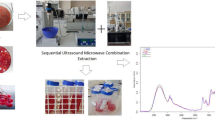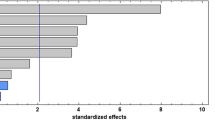Abstract
Roselle (Hibiscus Sabdariffa L.) has long been recognized as a source of natural food color additive. Microwave- and ultrasonic-assisted extraction are green and innovative processes widely used for natural dyes extraction. For this purpose, these two techniques as well as conventional extraction and their combination were proposed to extract total monomeric anthocyanins and total phenolics from roselle flowers. Ultrasonic-assisted extraction for 5 min yielded total monomeric anthocyanins of 13.47±0.22 mg/g and total phenolics of 163.23 ± 2.81 mg gallic acid/g of dried roselle flowers using 60% (V/V) aqueous ethanol and a solid/liquid ratio of 1/10 (g/mL). Microwave-assisted extraction required 10 min and microwave power of 180 W to extract higher monomeric anthocyanins and total phenolics. Conventional extraction required 24 h to obtain 14.46 ± 0.47 mg/g of total monomeric anthocyanins and 182.89 ± 2.49 mg gallic acid/g of total phenolics. The combination of ultrasonic- and microwave-assisted extraction reduced the extraction time from 24 h to 15 min and significantly (p≤0.05) increased total monomeric anthocyanin (17.36 ± 0.54 mg/g), total phenolics (208.28 ± 1.43 mg gallic acid/g), 2,2-diphenyl-1-picrylhydrazyl radical scavenging antioxidant activity and ferric-reducing antioxidant power by 28.88, 27.60, 73.41, and 85.77%, respectively, in comparison to ultrasound-assisted extraction. Fourier transform infrared showed that all extraction procedures did not affect the structural properties of roselle anthocyanins. This finding suggests the development of the use of green and innovative combined processes such as microwave and ultrasound for improving roselle pigment extraction for potential application in food and non food products.
Graphical Abstract






Similar content being viewed by others
Data availability
All data and findings of this study are available from the authors upon reasonable request.
References
Patel S (2014) Hibiscus sabdariffa: an ideal yet under-exploited candidate for nutraceutical applications. Biomed Prev Nutr 4:23–27. https://doi.org/10.1016/j.bionut.2013.10.004
Ali BH, Al Wabel N, Blunden G (2005) Phytochemical, pharmacological and toxicological aspects of Hibiscus sabdariffa L.: a review. Phyther Res 19:369–375. https://doi.org/10.1002/ptr.1628
Silva S, Costa EM, Calhau C et al (2017) Anthocyanin extraction from plant tissues: a review. Crit Rev Food Sci Nutr 57:3072–3083. https://doi.org/10.1080/10408398.2015.1087963
Pinela J, Prieto MA, Pereira E et al (2019) Optimization of heat- and ultrasound-assisted extraction of anthocyanins from Hibiscus sabdariffa calyces for natural food colorants. Food Chem 275:309–321. https://doi.org/10.1016/j.foodchem.2018.09.118
Paraíso CM, Januário JGB, Mizuta AG et al (2021) Comparative studies on chemical stability, antioxidant and antimicrobial activity from hot and cold hibiscus (Hibiscus sabdariffa L.) calyces tea infusions. Food Measure 15:3531–3538. https://doi.org/10.1007/s11694-021-00936-4
Abdallah EM (2016) Antibacterial activity of Hibiscus sabdariffa L. calyces against hospital isolates of multidrug resistant Acinetobacter baumannii. J. Acute Dis. 5:512–516
Pina F, Oliveira J, De Freitas V (2015) Anthocyanins and derivatives are more than flavylium cations. Tetrahedron 71:3107–3114. https://doi.org/10.1016/j.tet.2014.09.051
Ojeda D, Jiménez-Ferrer E, Zamilpa A et al (2010) Inhibition of angiotensin convertin enzyme (ACE) activity by the anthocyanins delphinidin- and cyanidin-3-O-sambubiosides from Hibiscus sabdariffa. J Ethnopharmacol 127:7–10. https://doi.org/10.1016/j.jep.2009.09.059
Wu CH, Huang CC, Hung CH et al (2016) Delphinidin-rich extracts of Hibiscus sabdariffa L. trigger mitochondria-derived autophagy and necrosis through reactive oxygen species in human breast cancer cells. J Funct Foods 25:279–290. https://doi.org/10.1016/j.jff.2016.05.018
Montalvo-González E, Villagrán Z, González-Torres S et al (2022) Physiological effects and human health benefits of Hibiscus sabdariffa: a review of clinical trials. Pharmaceuticals 15:1–33. https://doi.org/10.3390/ph15040464
Paraíso CM, dos Santos SS, Correa VG et al (2019) Ultrasound assisted extraction of hibiscus (Hibiscus sabdariffa L.) bioactive compounds for application as potential functional ingredient. J Food Sci Technol 56:4667–4677. https://doi.org/10.1007/s13197-019-03919-y
Pham TN, Le XT, Pham VT, Le HT (2022) Effects of process parameters in microwave-assisted extraction on the anthocyanin-enriched extract from Rhodomyrtus tomentosa (Ait.) Hassk and its storage conditions on the kinetic degradation of anthocyanins in the extract. Heliyon 8:e09518. https://doi.org/10.1016/j.heliyon.2022.e09518
Kurtulbaş E, Pekel AG, Bilgin M et al (2022) Citric acid-based deep eutectic solvent for the anthocyanin recovery from Hibiscus sabdariffa through microwave-assisted extraction. Biomass Convers Biorefinery 12:351–360. https://doi.org/10.1007/s13399-020-00606-3
Beye C, Hiligsmann S, Tounkara LS, Thonart P (2017) Anthocyanin content of two Hibiscus sabdariffa cultivars grown in Senegal. Agron Africaine Sp 29:63–68. https://doi.org/10.1016/j.ultsonch.2016.06.035
Jha AK, Sit N (2022) Extraction of bioactive compounds from plant materials using combination of various novel methods : a review. Trends Food Sci Technol 119:579–591. https://doi.org/10.1016/j.tifs.2021.11.019
Jafari R, Zandi M, Ganjloo A (2022) Effect of ultrasound and microwave pretreatments on extraction of anise (Pimpinella anisum L.) seed essential oil by ohmic-assisted hydrodistillation. J Appl Res Med Aromat Plants 31:100418. https://doi.org/10.1016/j.jarmap.2022.100418
Vega-Arroy JD, Ruiz-Espinosa H, Luna-Guevara JJ et al (2017) Effect of solvents and extraction methods on total anthocyanins, phenolic compounds and antioxidant capacity of Renealmia alpinia (Rottb.) maas peel. Czech J Food Sci 35:456–465
Sillero L, Prado R, Labidi J (2020) Simultaneous microwave-ultrasound assisted extraction of bioactive compounds from bark. Chem Eng Process - Process Intensif 156:108100. https://doi.org/10.1016/j.cep.2020.108100
Trujillo-Mayol I, Céspedes-Acuña C, Silva FL, Alarcón-Enos J (2019) Improvement of the polyphenol extraction from avocado peel by assisted ultrasound and microwaves. J Food Process Eng 42:1–11. https://doi.org/10.1111/jfpe.13197
Wizi J, Wang L, Hou X et al (2018) Ultrasound-microwave assisted extraction of natural colorants from sorghum husk with different solvents. Ind Crops Prod 120:203–213. https://doi.org/10.1016/j.indcrop.2018.04.068
Garcia-Vaquero M, Ummat V, Tiwari B, Rajauria G (2020) Exploring ultrasound, microwave and ultrasound-microwave assisted extraction technologies to increase the extraction of bioactive compounds and antioxidants from brown macroalgae. Mar Drugs 18:1–15. https://doi.org/10.3390/md18030172
Pham TN, Nguyen TPN, Lam TD et al (2019) Effects of various solvent concentration, liquid-solid ratio, temperatures and time values on the extraction yield of anthocyanin from Vietnam Hibiscus sabdariffa L. (Roselle). IOP Conf Ser Mater Sci Eng 542:1–5. https://doi.org/10.1088/1757-899X/542/1/012033
Alara OR, Abdurahman NH, Obanijesu EO et al (2020) Extract-rich in flavonoids from Hibiscus sabdariffa calyces: optimizing microwave-assisted extraction method and characterization through LC-Q-TOF-MS analysis. J Food Process Eng 43:1–13. https://doi.org/10.1111/jfpe.13339
Yusoff NI, Leo CP (2017) Microwave assisted extraction of defatted roselle (Hibiscus sabdariffa L.) seed at subcritical conditions with statistical analysis. J Food Qual 2017:1–10. https://doi.org/10.1155/2017/5232458
Chumsri P, Sirichote A, Itharat A (2008) Studies on the optimum conditions for the extraction and concentration of roselle (Hibiscus sabdariffa Linn.) extract. Songklanakarin J Sci Technol 30:133–139 (http://www.sjst.psu.ac.th)
Giusti MM, Wrolstad RE (2001) Characterization and Measurement of Anthocyanins by UV-visible Spectroscopy. In: Current Protocols in Food Analytical Chemistry, John Wiley. p F1.2.1–F1.2.13
Singleton VL, Rossi JA (1965) Colorimetry of total phenolics with phosphomolybdic-phosphotungstic acid reagents. Am J Enol Vitic 16:144–158
Menaceur F, Benchabane A, Hazzit M, Baaliouamer A (2013) chemical composition and antioxidant activity of Algerian Juniperus phoenicea L. extracts. J Biol Act Prod from Nat 3:87–96. https://doi.org/10.1080/22311866.2013.782754
Ghaliaoui N, Mokrane H, Hazzit M et al (2020) Impact of freezing and drying preprocessing on pigments extraction from the brown seaweed « Phyllaria reniformis» collected in Algerian coast. Carpathian J Food Sci Technol 12:81–94. https://doi.org/10.34302/CRPJFST/2020.12.3.6
Benzie IFF, Strain JJ (1999) Ferric reducing/antioxidant power assay: direct measure of total antioxidant activity of biological fluids and modified version for simultaneous measurement of total antioxidant power and ascorbic acid concentration. Methods Enzymol 299:15–27. https://doi.org/10.1016/S0076-6879(99)99005-5
The R Foundation (2020) The R Project for Statistical Computing. Version R 4.0.2. https://www.r-project.org/
Duval J, Pecher V, Poujol M, Lesellier E (2016) Research advances for the extraction, analysis and uses of anthraquinones: a review. Ind Crops Prod 94:812–833. https://doi.org/10.1016/j.indcrop.2016.09.056
Redzuan S, Ho CY, Idham Z et al (2021) Optimization of anthocyanins extracts from Roselle (Hibiscus sabdarifa) petals using ultrasonic-assisted extraction method. In: Zaini MAA et al. (ed) Proceedings of the 3rd International Conference on Separation Technology. Springer Singapore, pp 295–309. https://doi.org/10.1007/978-981-16-0742-4_21
Aryanti N, Nafiunisa A, Wardhani DH (2019) Conventional and ultrasound-assisted extraction of anthocyanin from red and purple roselle (Hibiscus sabdariffa L.) calyces and characterisation of its anthocyanin powder. Int Food Res J 26:529–535
Yuniati Y, Elim PE, Alfanaar R et al (2021) Extraction of anthocyanin pigment from Hibiscus sabdariffa L. by ultrasonic-assisted extraction. IOP Conf Ser Mater Sci Eng 1010:1–6. https://doi.org/10.1088/1757-899X/1010/1/012032
Jiménez-González O, Guerrero-Beltrán JÁ (2021) Extraction, microencapsulation, color properties, and experimental design of natural pigments obtained by spray drying. Food Engineering Reviews. Springer, US, pp 769–811
Alara OR, Abdurahman NH, Ukaegbu CI, Azhari NH (2018) Vernonia cinerea leaves as the source of phenolic compounds, antioxidants, and anti-diabetic activity using microwave-assisted extraction technique. Ind Crops Prod 122:533–544. https://doi.org/10.1016/j.indcrop.2018.06.034
Wen Y, Chen H, Zhou X et al (2015) Optimization of microwave assisted extraction and antioxidant activities of anthocyanins from blackberry using response surface methodology. RSC Adv 5:19686–19695. https://doi.org/10.1039/c4ra16396f
Pimentel-Moral S, Borrás-Linares I, Lozano-Sánchez J et al (2018) Microwave-assisted extraction for Hibiscus sabdariffa bioactive compounds. J Pharm Biomed Anal 156:313–322. https://doi.org/10.1016/j.jpba.2018.04.050
Liazid A, Guerrero RF, Cantos E et al (2011) Microwave assisted extraction of anthocyanins from grape skins. Food Chem 124:1238–1243. https://doi.org/10.1016/j.foodchem.2010.07.053
Bouras M, Chadni M, Barba FJ et al (2015) Optimization of microwave-assisted extraction of polyphenols from Quercus bark. Ind Crops Prod 77:590–601. https://doi.org/10.1016/j.indcrop.2015.09.018
Zhang J, Huang X, Shi J et al (2021) A visual bi-layer indicator based on roselle anthocyanins with high hydrophobic property for monitoring griskin freshness. Food Chem 355:129573. https://doi.org/10.1016/j.foodchem.2021.129573
Wang W, Ma X, Xu Y et al (2015) Ultrasound- assisted heating extraction of pectin from grapefruit peel: optimization and comparison with the conventional method. Food Chem 178:106–114. https://doi.org/10.1016/j.foodchem.2015.01.080
Acknowledgements
Authors are grateful for the financial support from the Algerian Ministry of Higher Education and Scientific Research (PRFU n°B00L01EN160220180003) and socio-economical project n°85 of 2021. Authors deeply thank Pr. Ferhat Mohamed Amine and Dr. Fahima Abdellatif-Dahmane for kindly providing Microwave and Utrasound systems.
Funding
This research was funded by the Algerian Ministry of Higher Education and Scientific Research, PRFU grant number B00L01EN160220180003 and socio-economical project grant number 85/2021.
Author information
Authors and Affiliations
Contributions
All authors contributed to the study conception and design. Material preparation, data collection, and analysis were performed by Habiba Boukerche, Nora Ghaliaoui, Nawel Saidji, Ahmed Bensalem, and Fatiha Malki. The first draft of the manuscript was written by Habiba Boukerche. Writing—review and editing: Hind Mokrane and Habiba Boukerche. All authors commented on previous versions of the manuscript. All authors read and approved the final manuscript. Supervision: Hind Mokrane.
Corresponding author
Ethics declarations
Ethical approval
Not applicable.
Competing interests
The authors declare no competing interests.
Additional information
Publisher's note
Springer Nature remains neutral with regard to jurisdictional claims in published maps and institutional affiliations.
Rights and permissions
Springer Nature or its licensor (e.g. a society or other partner) holds exclusive rights to this article under a publishing agreement with the author(s) or other rightsholder(s); author self-archiving of the accepted manuscript version of this article is solely governed by the terms of such publishing agreement and applicable law.
About this article
Cite this article
Boukerche, H., Malki, F., Saidji, N. et al. Combination of ultrasound, microwave and conventional extraction techniques for roselle (Hibiscus Sabdariffa. L.) total anthocyanins and phenolics recovery: effect on antioxidant and structural properties. Biomass Conv. Bioref. (2023). https://doi.org/10.1007/s13399-023-04029-8
Received:
Revised:
Accepted:
Published:
DOI: https://doi.org/10.1007/s13399-023-04029-8




